Engagement Ring - In Progress
Setting
Stone
Purchase any Engagement Ring and receive a $250 Gift Card for your Wedding Band. Ends soon.
Deepen the well of love in the world.
So you want major bling for your ring? I got you. When most people think about a huge diamond, a 3 carat diamond ring is what they’re imagining! This kind of carat weight packs a huge punch, so it’s a great size to go for when you’re looking for impact. However, did you know there’s ways to make a 3 carat diamond ring look even bigger and better? Read on!
Yes! The average diamond ring is between 1-2 carats, making a 3 carat diamond a big look! However, not all 3 carat stones “look” 3 carats. That’s because a “carat” is a weight measurement, not a diameter size. That also means that you can find a 3 carat stone that looks closer to 3.25 or even 3.50ct! It’s all in where the diamond carries its weight – whether that be in its bottom, or across its width. I’ll show you how to look for this below!
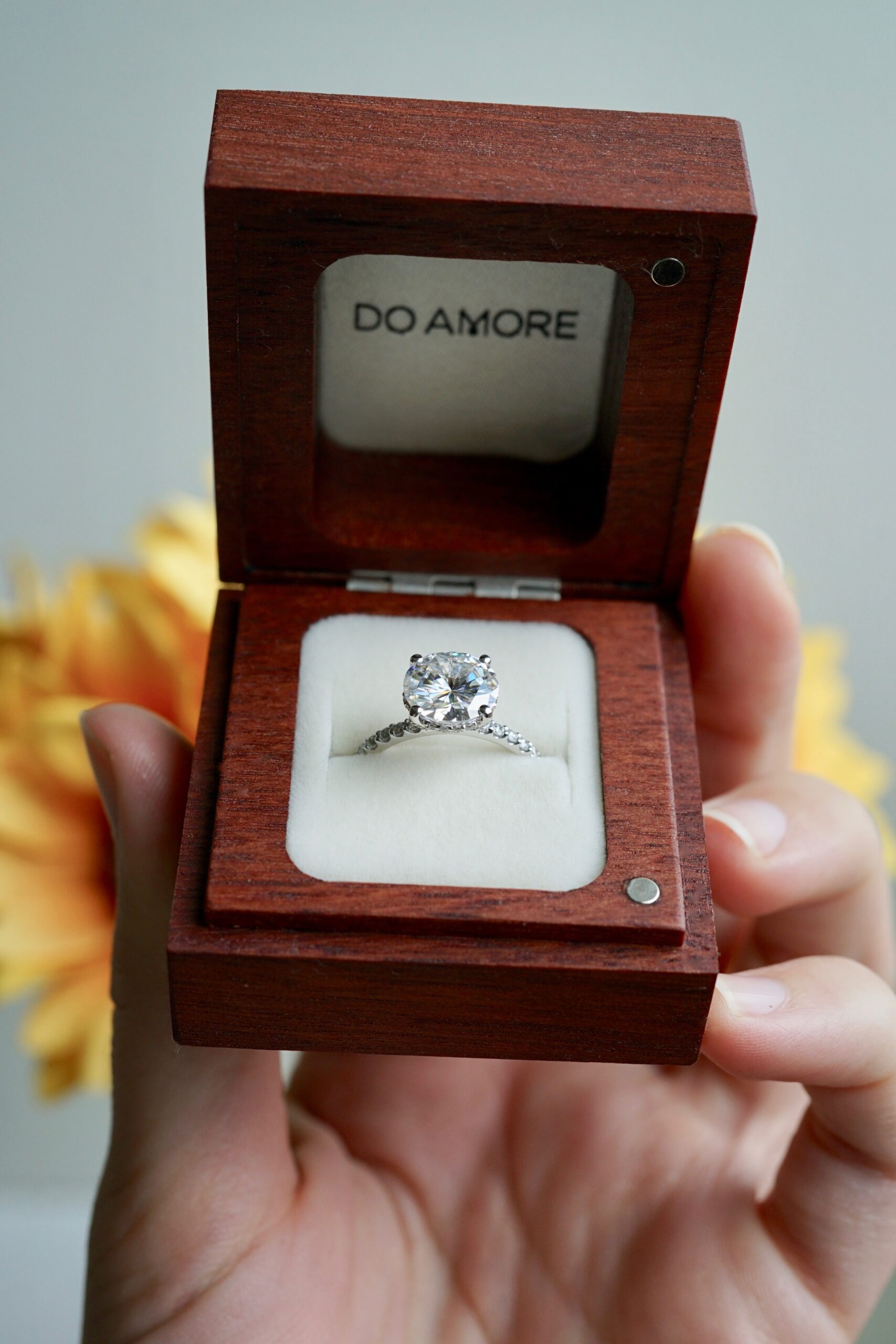
At the time of writing, a white, eye clean, natural 3 carat diamond begins around $30,000, and lab diamonds of a similar quality begin around $7,500! Diamonds vary greatly in price depending upon their specific 4Cs (color, cut, clarity, and carat weight) as well as diamond origin (lab or natural)! Even small differences can make a pretty significant difference in price. You can read more about how to get the best bang for your buck, while getting a beautiful white, eye clean diamond here! Once you choose shape, origin, and a range of color, clarity – shoot us an email at care@doamore.com. We’re always happy to run a custom search for you for the best values out there!
Pro tip: Also, you can see some of our recommended natural diamonds here and recommended lab diamonds here (these diamonds have been selected based on maximizing beauty and bang for your buck!).
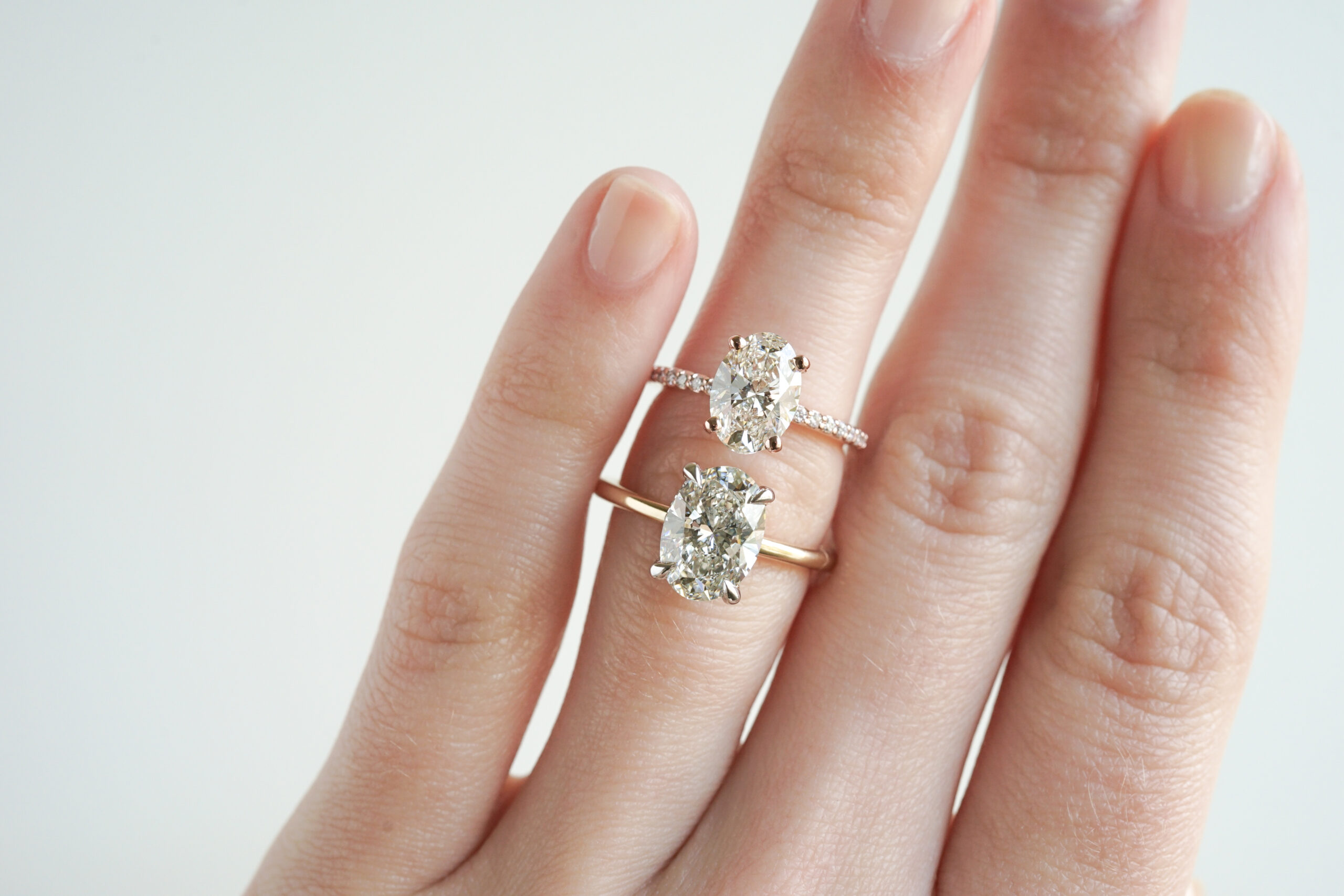
2.25ct vs 3 carat diamond ring
One way to make your 3 carat look even bigger is to choose an elongated fancy shape. Long shapes such as ovals, emeralds, radiants, and marquise look larger than their more rounded cousins. This is because their length gives the appearance of a larger surface area! So, if you’re going for max bang for your buck, choosing an elongated shape can get you an even bigger look!
Remember, “carat weight” is a weight measurement – so in order to get max bang for your buck, always look at measurements. It may be that you can get a great value by choosing a 2.9-2.99 carat that measures just as large as a 3.00-3.10ct! So, when looking for the best 3 carat diamond ring, set your filters just a hair below 3 carats, and then compare measurements. Check it out:

You don’t need a completely colorless, VVS diamond to get a big fancy look. To get the max bang for your buck, choose “white, eye clean” instead of falling for the “colorless” thing. G colored diamonds will look colorless face up! And, with the exception of emerald and asscher cuts (that mostly need to be VVS), VS diamonds are just as eye clean as Flawless and VVS stones. Don’t waste money on things you can’t see! Instead, choose G (and sometimes even H!) color and VS clarity, and then put that extra money towards more carats!
Well cut, sparkly diamonds ALWAYS look bigger than less sparkly diamonds. This is because “dead” stones without much sparkle do not really “pop” from the finger. So, in addition to looking for big measurements, always make sure to learn how to get the most sparkle from your stone too. Every shape has unique features to look for. Check out our round guide here, our oval guide here, and guidelines for emerald cuts here!
Pro Tip: EVERY shape needs even contrast and brilliance. Contrast is the dark background white and rainbow sparkle pops from! So, always look for an even smattering of dark/light in your gem to make sure it’ll sparkle like crazy!
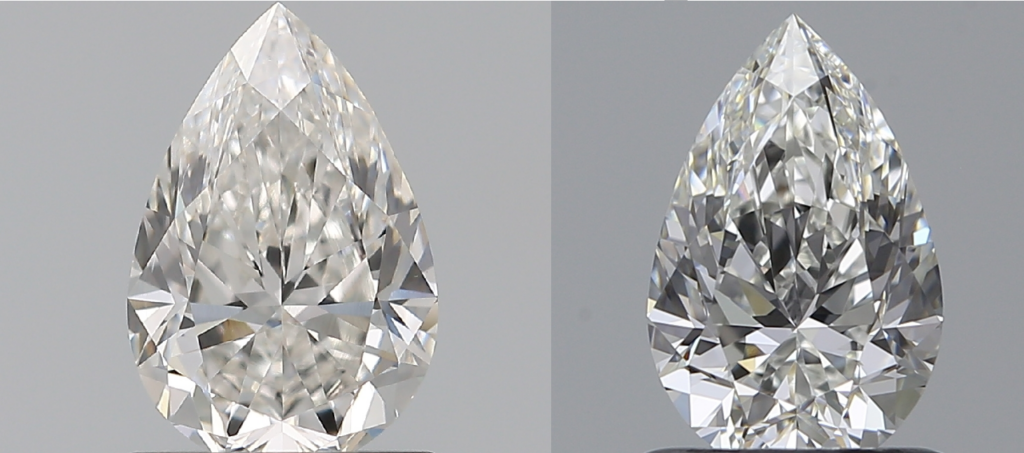
Round cut diamonds are the most popular shape, and have the most sparkle. So, it’s an easy, classic choice for a beautiful 3 carat diamond ring! Rounds are the most technically challenging cut to get “perfect” as they need very specific angles to maximize sparkle. You can learn how to master those angles and get the best Round 3 carat here.
At the time of writing, white, eye clean, natural 3 carat round diamonds begin around $38,000, and lab diamonds of a similar quality begin around $8,200. Then, simply pick your favorite setting, such as our blingy Mekelle for $1,580 in any color gold!
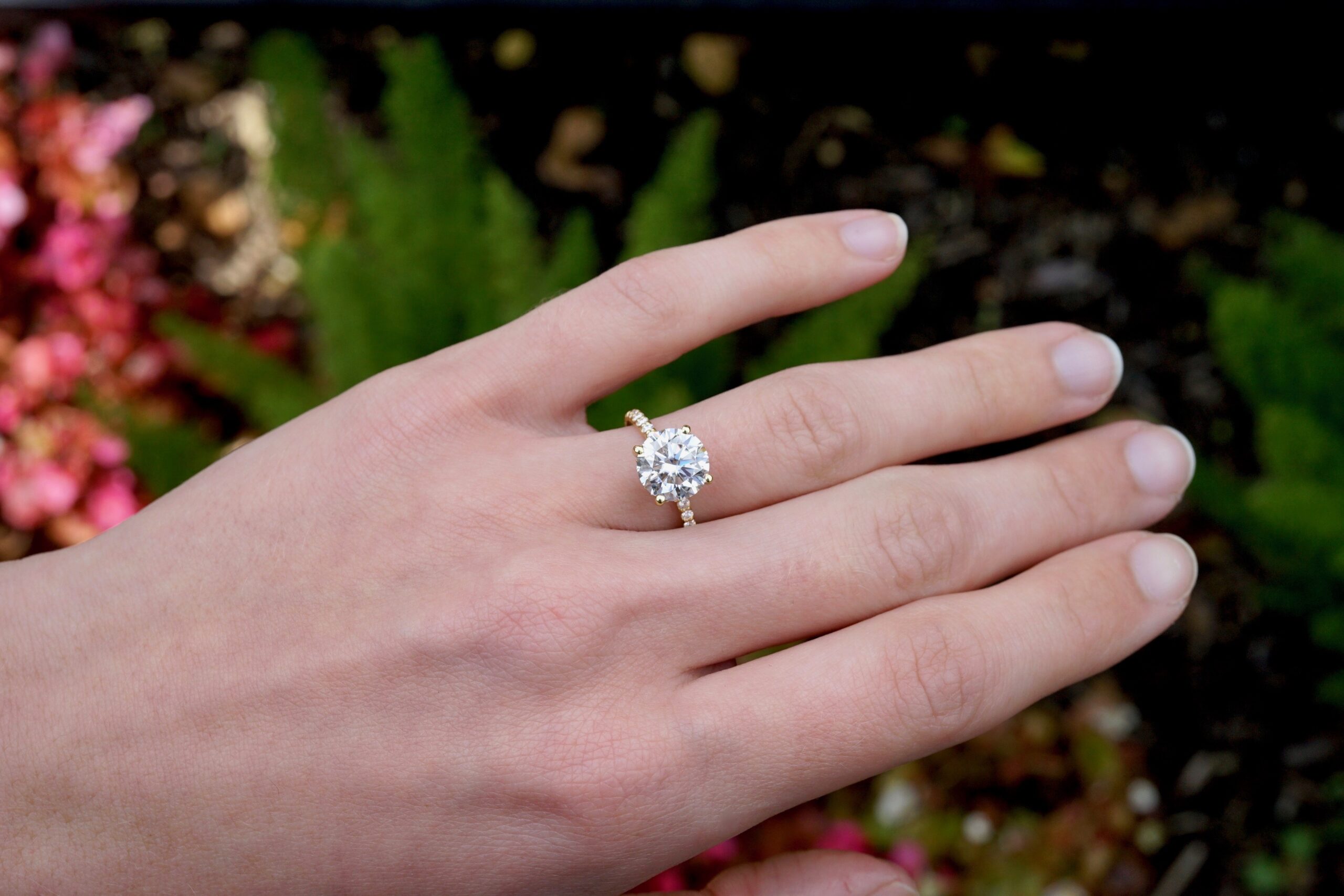
3 carat ovals look even bigger than their round cousins! That is because an oval’s nice long length gives it a larger appearance. Learn how to choose the best oval (and avoid dark bowties) here!
At the time of writing, white, eye clean, natural 3 carat oval diamonds begin around $34,000, and lab diamonds of a similar quality begin around $10,000. Choose a beautiful setting, such as our dainty Diana ($880 in any color gold)!
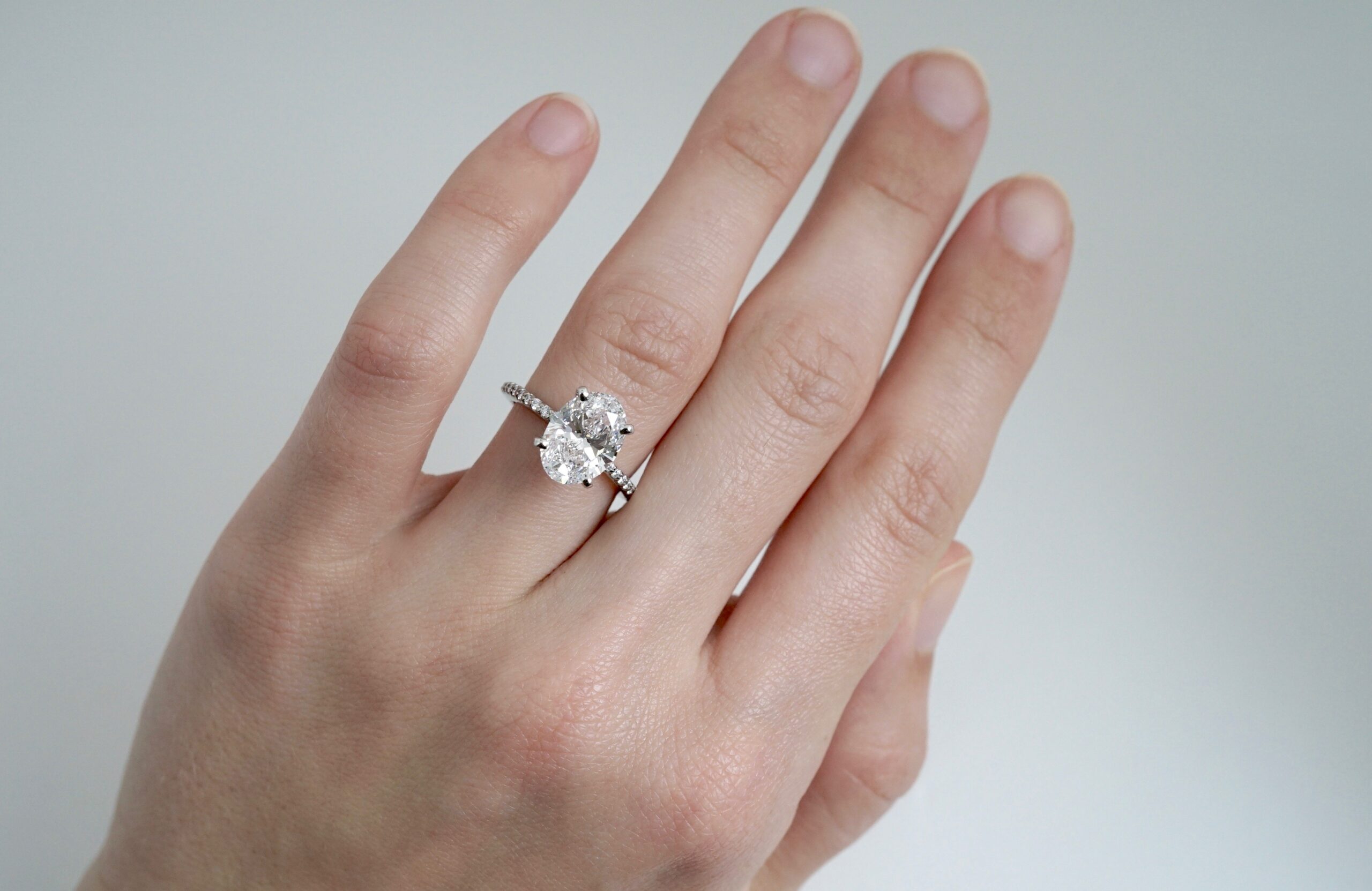
Huge emerald cut rocks are celebrity favorites! Think Elizabeth Taylor, Melania Trump, and Paris Hilton! Shining and elegant, large emerald cut diamond rings stand for high end class. That is because emerald cut diamonds require a higher color (G+) and clarity (VS1+) than other cuts to look “white and eye clean”.
At the time of writing, white, eye clean, natural 3 carat emerald cut diamonds begin around $38,000, and lab diamonds of a similar quality begin around $11,000. Choose a beautiful setting, such as our classic Asha ($450 in any color gold)!
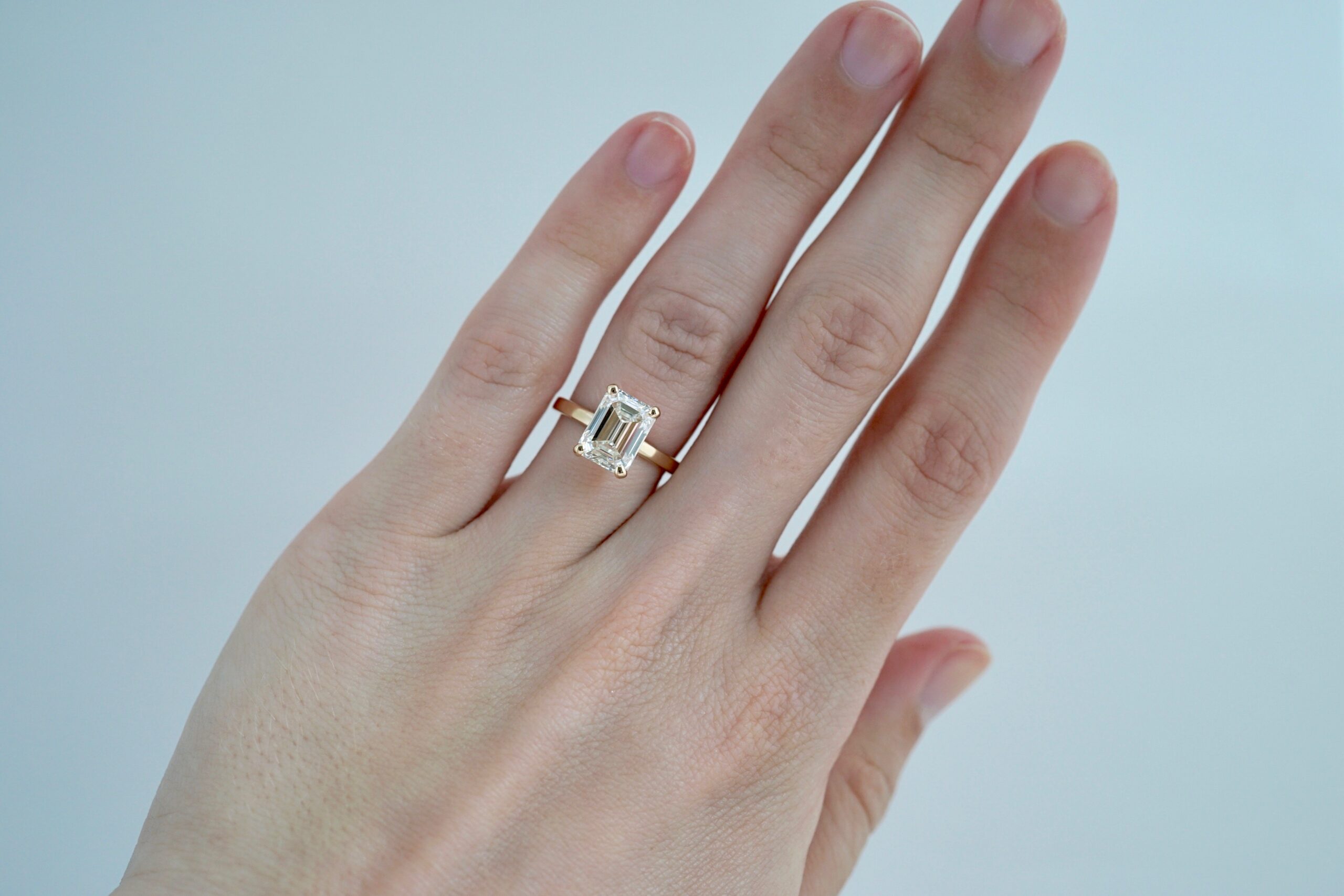
Yes! We specialize in making sure you get the biggest, best diamond for your money. You can checkout our blog dedicated to it here. So, when looking for the best 3 carat diamond ring, you’ve come to the right place. Email us here, or drop us a line here, and we’ll set out on the hunt for you!
Oval cut diamonds are stunning and look larger than rounds of similar carat weight! But, because the GIA does not grade oval cut diamonds for cut quality, you’ve got your work cut out for you! In addition to standard oval guidelines, there are extra factors you should consider to get the most sparkly, beautiful stone. In this article, we’ll teach you how to spot good contrast and brilliance, avoid ugly oval diamond bowtie and dark tips, as well as all about oval cut diamond fisheyes!
Want to know more? Read on!

(left) washed out; (middle) even contrast/brilliance oval; (right) too much contrast
Pick an oval cut diamond with evenly spaced “contrast” (dark areas in a diamond) and “brilliance” (white sparkle in a diamond). Yes, you heard correctly! You do actually want some dark areas in your diamond, or else the stone’s sparkle will not show up as well. Still don’t believe me? Think about photographing a white cup against a white piece of paper. Detail is lost, and there’s nothing interesting to look at. Now, imaging that same white cup against a black piece of paper. Wow! Curves, shadows, reflections! The dark background makes that white ceramic POP! Now imagine what it does for a multi-faceted, white-and-rainbow-flashing diamond! In other words, contrast makes your diamond more beautiful, more interesting, and more dramatic!
Contrast also helps to hide dark bowties and tips – which is especially important in an oval diamond (more on that later :). So, when looking for the best oval cut diamond, make sure that your stone has a good smattering of dark contrast amongst your beautiful white sparkle!
Pro tip: Watch the diamond’s facets as your stone turns. Do they stay one color, or do they flash from dark to light? You want the flash, believe me!
Too much dark contrast in the center of your oval cut diamond that looks like a black bowtie is just not attractive, avoid it! Likewise, watery, washed out bowties are not very pretty either. You want a bowtie area with even contrast and brilliance (there it is again!) I receive oval diamond bowtie questions all the time, and there’s a lot of misinformation out there about them – let’s get it straightened out.

(left) watery bowtie; (middle) well balanced bowtie area; (right) dark bowtie
Yes, all oval cut diamonds have bowties. Though like James Bond’s vs Bill Nye’s, some are simply better than others. An oval cut diamond’s bowtie is in its middle, as a result of this cut’s nice long length! Necessarily, oval facets are shorter width wise, and longer length wise. Thus, an oval diamond’s middle will always look different than its tips! It wears a bowtie!
A diamond bowtie occurs when width facets are shorter and are steeper than its length facets. These differences in depth and angles cause light to refract differently in an oval’s center vs its tips. So, if a cutter is not careful, those deep center facets can turn into a dark oval diamond bowtie! But there’s hope! Skilled diamond cutters will avoid dark bowties and also include well placed contrast throughout the stone to make an even appearance.
Yes, an overly dark bowtie, or a watery bowtie, can look pretty bad. The goal is to look for a stone in which the cutter has blended the bowtie in. This means looking for a stone that has both contrast and brilliance not only in the bowtie area, but also in the tips.
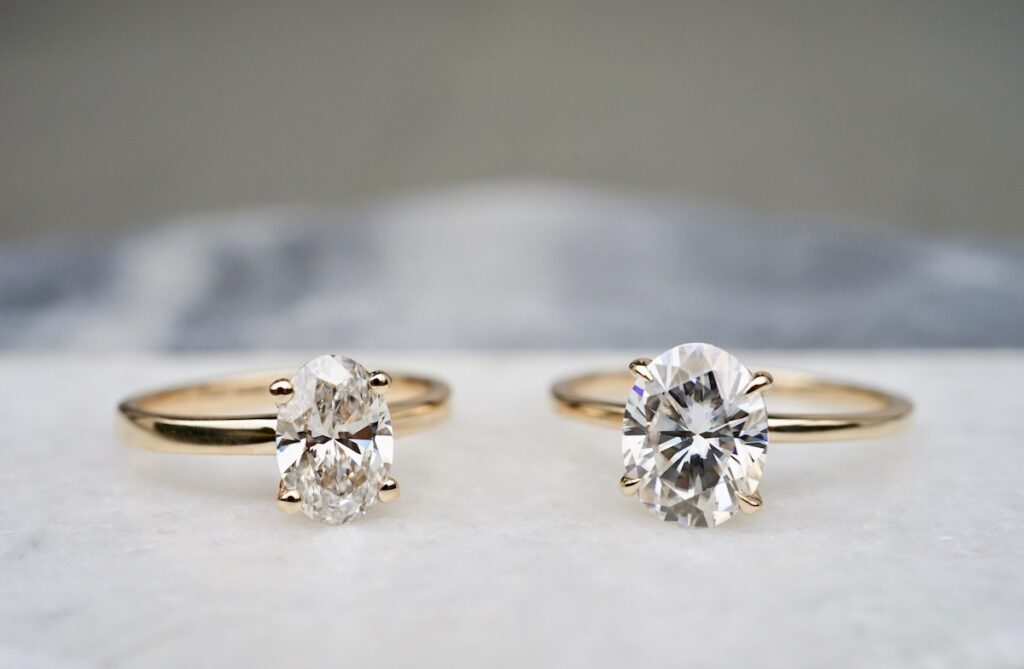
Oh, you fancy, huh? Oval diamonds are considered “fancy” shapes – and for good reason! There’s several different shape considerations and cutting styles to choose from! End (or “tip”) style, pavilion main (I like to call this “star ray”) style, length ratio, and shoulder curve…the list goes on! Check it out:
An oval diamond’s “tips” (also called “ends“) are the soft round arcs at each end! These tips can be cut with one larger diamond shaped facet, or can be faceted with several! While I do not necessarily recommend one over the other, two things are for certain: avoid dark or overly colored tips.
Dark tips take away from the beauty of your stone. This most frequently occurs in diamonds with one flat facet on each tip, and very infrequently in stones with multi-faceted tips. That’s because it’s easier to break up overly dark contrast with more facets at more angles. This doesn’t mean you should throw out all ovals with single facet tips – just to learn what to look for. Watch the 360 video of your stone closely – do the tips look dark as it spins? If so, reject it! Dark tips take away from sparkle and brilliance.

Dark oval tips (left); bright clear oval tips (middle); color concentration in oval tips (right)
Don’t buy a diamond with more warmth in its tips than its center. Because diamond tips are shallower than its middle (and thus have less opportunity to refract light), they often show more color. So, while you’re looking at that beautiful spinning sparkler, take a look at the color of the tips compared with its belly. Are they the same? Or is there a concentration of warmth in the tips? If the tips look warmer than the rest of the diamond, pass. Color consistency is key!
Ovals can be cut with 4, 6, or 8 pavilion mains (which look like 4, 6, or 8 rayed stars). One cutting style is not better than another, it is personal preference! Some people prefer the look of a 4 ray which has big bold facets, others like the interesting pattern of the 6 (6s are rare!), and many prefer the added liveliness and pinfire bling of an 8 (this is the most widely cut). Check them out here, which is your favorite?
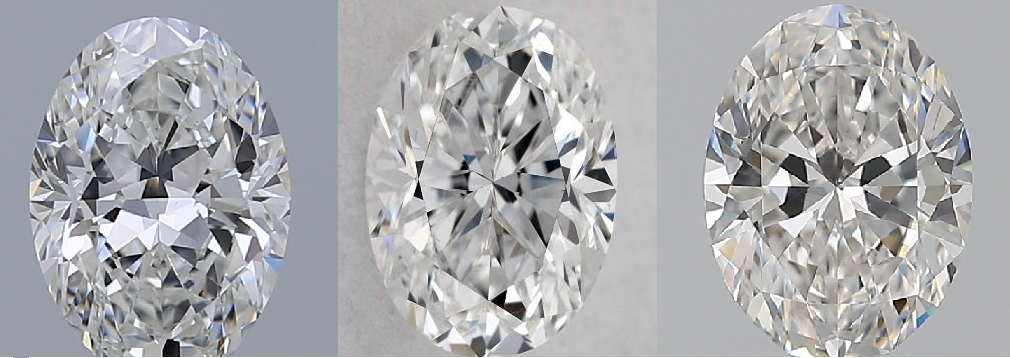
4, 6, and 8 pavilion main diamonds
Choosing a graceful shoulder curve boosts both beauty and value. A diamond’s shoulder curve is the arc between its belly (its bowtie area) and its tips. An ideal oval cut diamond shoulder is soft and curving. However, shoulders can also look flat (approaching a marquise look) or square/heavy (approaching an elongated cushion appearance). So, take some time and look at the outline of your oval. Is it soft and appealing? Or does it feel bulky or overly harsh? You’re choosing an oval for its shape – so pick one you like!
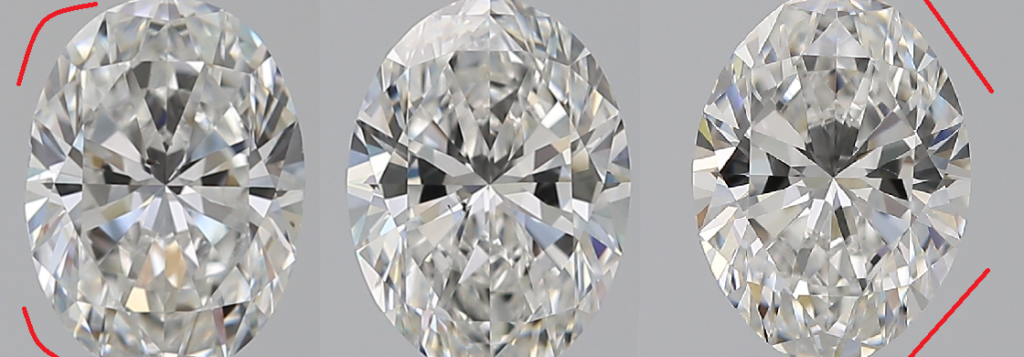
(left) bulky shoulders; well proportioned oval; flat shoulders (right)
Length to width ratio shows you how long and skinny or wide and plump your oval cut diamond will be. While it sounds kind of technical and complicated, it is actually only the length measurement of a diamond divided by its width. That’s it!
Most people say the ideal length-to-width ratio of an oval is 1.35-1.50. Diamonds that fall within this range will not be too round, or too pointy! The lower the ratio, the plumper the oval. Likewise, the higher the ratio, the skinnier! One perk of a higher length-to-width oval ratio is that skinny ovals appear larger than their carat weight due to their length. However, it all comes down to personal preference. Some people prefer rounder ovals (at its extreme, we call it a roval – a round oval) while the opposite extreme prefers a very tall, thin oval (we call his a moval – a marquise oval). These outliers can have a lot of character!

1.35, 1.40, 1.45, and 1.50 length-to-width ratios
Nothing is worse than a perfect-on-paper oval that’s littered with random weird reflections. Ok, there’s probably a few worse things, but still, the point stands. So, to get the most beautiful oval, you have to know what you’re looking for. A fisheye is when a diamond’s girdle (it’s very outside edge) reflects awkwardly under its table, making a ghostly white ring. It’s not very attractive – nix them! Additionally, due to their length, oval cut diamonds can show other odd reflections, too. So while you’re watching that diamond spin – look under the table (the big top facet). Are there weird reflections that mess with your sparkle? Pass! The best ovals will have crisp, clean facets showing – you guessed it – even brilliance and contrast.

Fisheyes and odd reflections in oval cut diamonds
You betcha! I love ovals – and so does Krish, our founder, he proposed with one! Write to either (or both!) of us at care@doamore.com and we will custom curate a selection of stunning ovals for you to choose from – all with max bang for your buck!
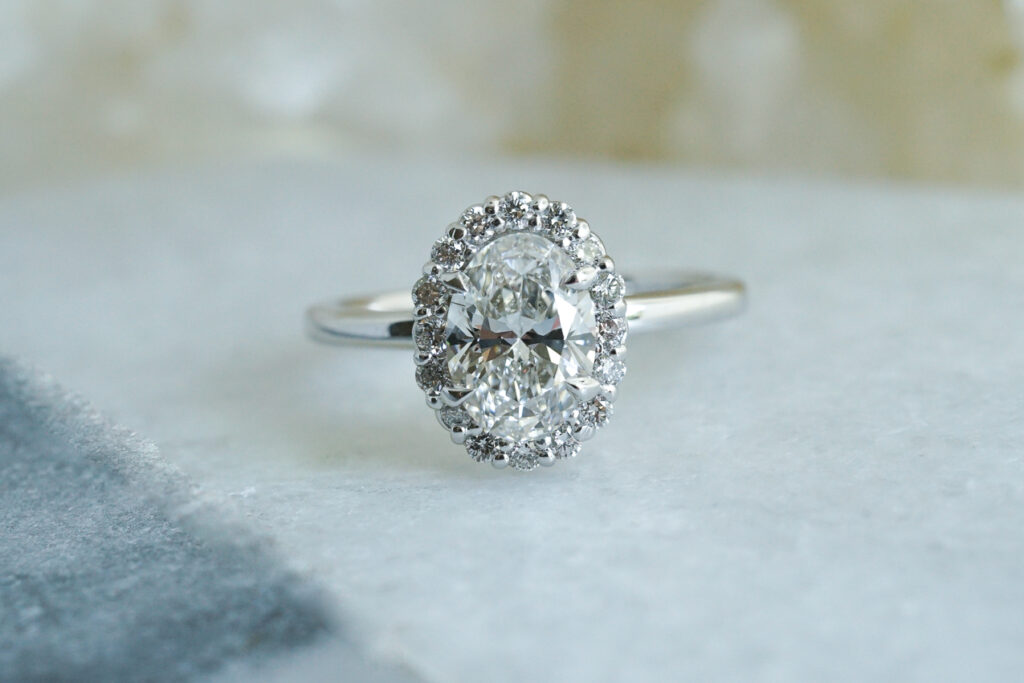
I could scroll through pictures of Cushion cut halo engagement rings ALL DAY. So classic, yet so current! And it’s no wonder that brides love this look so much. This style has been around for a century – and will likely be around for many more! So, if you’re looking for a Cushion cut halo engagement ring, you’ve made a great choice. Now let’s make sure you get a great diamond, and a great deal!
A Cushion cut halo engagement ring is a ring style that includes a large center stone surrounded by a pillow-shaped frame of small diamonds (its “halo”). Simple right? However, there’s plenty of options to choose from to make your cushion cut halo ring special.
One of the first things to think about is whether you’d like your cushion to be more square or more elongated and rectangular. Cushion cut diamonds can be squarish, or they can be nice and long, and so can their halos! Both of these styles are great and offer flexibility for choosing a unique center stone. Women with long fingers may prefer an elongated cushion halo. Couples who prefer a more traditional look may prefer a more squared-off halo.
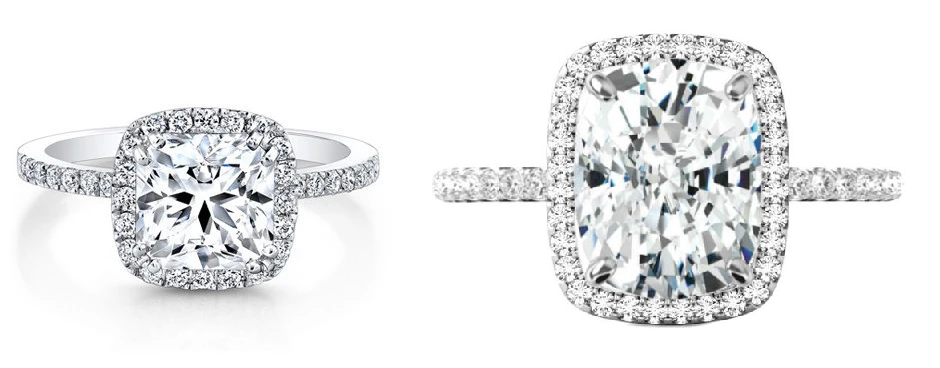
(left) Square cushion cut halo engagement ring vs Elongated cushion cut halo engagement ring (right)
Just because the your halo is cushion shaped doesn’t mean your center stone needs to be! While some couples prefer to have a Cushion cut diamond in the center, others like to mix it up and choose Round, Oval, Princess, or even Radiant cuts surrounded by a cushion frame. All these styles are beautiful and pack a ton of pizzazz!

Another consideration is the band upon which your cushion cut halo sits. Do you want it to be simple, and let the halo be the center of attention? Or, do you want to bling out the band, too? There are so many options here. It can be a single band, or a double, or even a triple! In addition, split-shank bands are always a great choice, as the branched band looks like it’s cradling the cushion!

Plain band, wavy band, triple band
How the diamonds are set in your ring is another consideration. Firstly, the center stone can be “prong-set,” with little claws holding the stone in place. Or, it can be “bezel-set,” with a dainty rim encircling the center stone. Secondly, if you choose prongs, they can be the same color as the rest of the ring or a contrasting color for a unique take. Finally, the mini diamonds that cover the halo and band can be prong-set, or they can be pavé set. “Pavé,” pronounced pah-VAY, really means paved into the ring! So, there’s a lot of room for customization.
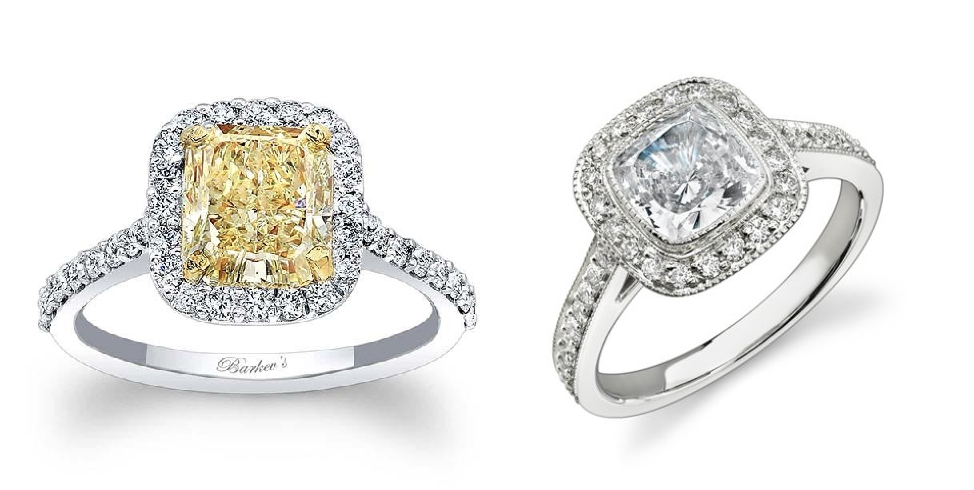
Center stones set in prong (left) and bezel (right) styles
Do Amore creates Cushion cut halo engagement rings in white, yellow, and rose gold, as well as platinum and palladium! That’s because all of these colors and metals look great in this style. A few of our favorite combinations are Diamond in white gold, white sapphire in rose gold, and yellow sapphire in yellow gold!
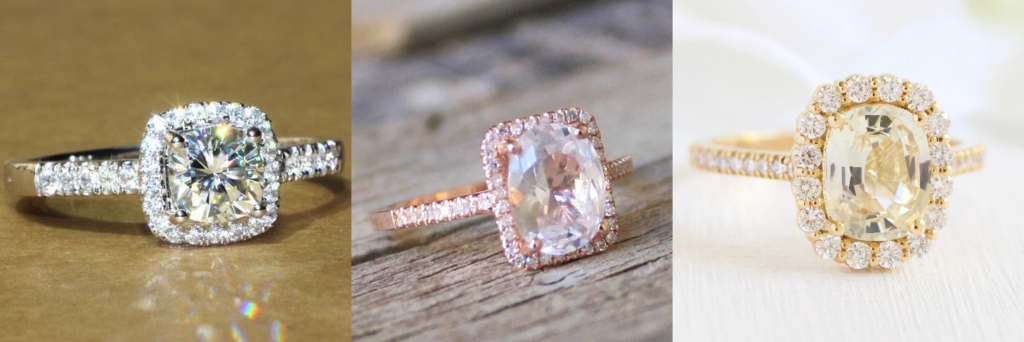
White gold (left), rose gold (middle), and yellow gold (right)
Cushion cut diamonds were the first “modern brilliant” cuts made. In other words, they were the first diamonds cut to maximize sparkle. For this reason, people also refer to them as “mine” diamonds. Because of their significant history, some of the most famous diamonds in the world are Cushion cut. For example, famous Cushions include the Regent Diamond, three of the Cullinan Diamonds, and the Hope Diamond (which you’ll notice is also in a halo!)

Cullinan Diamonds and Hope Diamond
Cushions can be tricky, as they’re all cut differently. Some of them look more vintage, while others look very modern! Here are your steps to create the perfect Cushion cut halo engagement ring with a Cushion center:
Square cushions will fall between 1.00 to 1.05 length-to-width ratio. The closer to 1.00 the gem is, the more square it will look. Elongated cushions fall between 1.06 and 1.25. The bigger the number, the longer your Cushion cut will be. Both look great in a Cushion cut halo engagement ring.
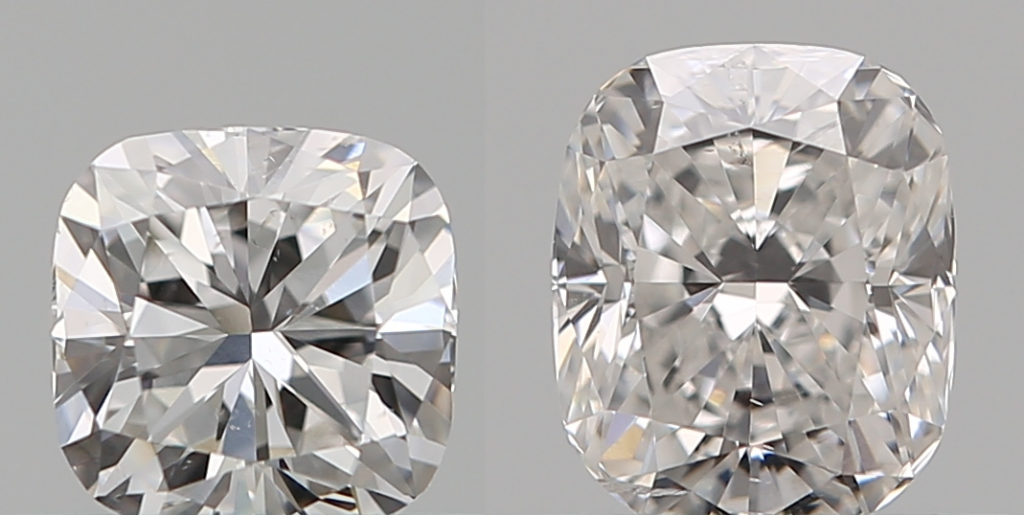
(left) Square cushion vs Elongated cushion (right)
Traditionally cut Cushions look antique, with big, chunky facets, and large flashes of light. Other Cushions have smaller facet patterns and show a larger amount of smaller-size sparkle (people often call this “crushed ice.”) This is a personal preference, both cuts are perfect!
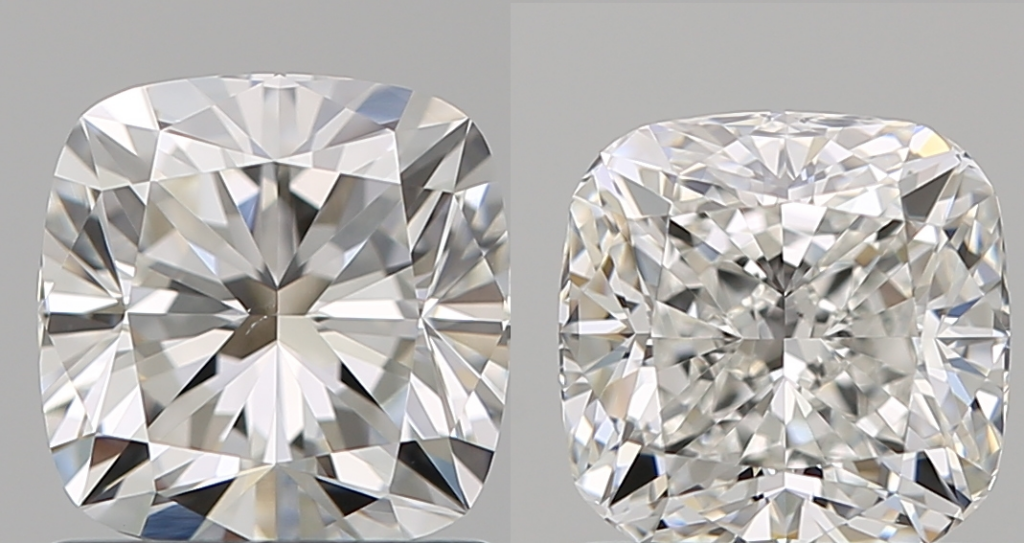
(left) traditional “chunky” cushion vs crushed ice cushion (right)
One trap to beware of is a Cushion’s depth. Many Cushions are upwards of (and sometimes over!) 70% deep, meaning they carry weight in their bottoms where you can’t see it. That means you’ll pay for weight you don’t get to benefit from! So, when you set your parameters, make sure to set a max of 68% in depth percentage – and look for stones with an even shallower depth. Learn more about choosing the perfect Cushion cut here!
Cushion cuts can show odd reflections and dark patches that take away from the beauty of the stone – stay away from them! “Fisheyes” refer to circular white reflections in your stone. These are reflections of the exterior girdle (see the second stone below). Make sure your stone doesn’t have one! “Contrast” is the term for dark areas in your stone. Contrary to popular belief, some contrast is good! It’s what gives your stone a background for sparkle to pop (without it, your stone will be less lively – see the first stone below). You want it to be evenly spaced throughout your stone (third stone), not in weird patches (fourth stone!).

Not enough contrast (first); Fisheye (second); Excellent cut Cushion (third); Odd contrast (fourth)
To ensure a high-end look, make sure that your ring’s halo echos the length-to-width ratio of your center stone. If you have an elongated Cushion, and the halo is a square, it’s going to look mismatched. Likewise, a square Cushion put into a rectangular halo will look as if a mistake has been made. So, always ensure your Cushion cut halo engagement ring matches the length of your Cushion cut center stone. At Do Amore, we make every ring from scratch to ensure your diamond fits perfectly!
Round cut diamonds are classic and stunning. Out of all the shapes, they produce the most sparkle! The most important things to consider in a Cushion cut halo engagement ring with a Round center stone are:
Because Rounds were cut to return the most light, they also have the most to lose. So, focusing on the quality of your Round diamond’s cut is your #1 priority. Diamonds without an Excellent cut can look lifeless – why spend money on that?! Mathematicians have actually figured out what angles a Round diamond needs to produce excellent light return. Here’s a quick overview:
After you find a gem within these parameters, then compare the angles. Small table? Pick a steep crown and a shallow pavilion. Large table? Go with a shallow crown and a steep pavilion. This will give you max light return. Learn more about why cut matters so much in our 3 Big Mistakes to Avoid in a Round Engagement Ring post here!
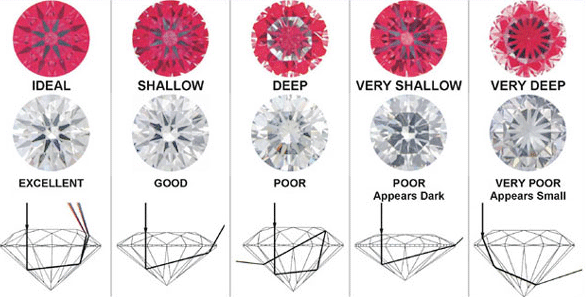
“Carat weight” is a measurement for how heavy your diamond is – not how big it looks! In other words, you can have a 1.0ct diamond that is 6.3mm, 6.5mm, or 6.7mm in diameter. In order to get the biggest look in your Cushion cut halo engagement ring, always maximize your measurements within ideal proportions for your carat weight.
When choosing a Round cut diamond to set in your Cushion cut halo engagement ring, it can sometimes look like there’s unused space in the corners of the cushion halo. This gives an unfinished, sloppy look. In order to avoid this, ensure that your Round diamond is wide enough to span the full gap, or consider double prongs to fill the space.
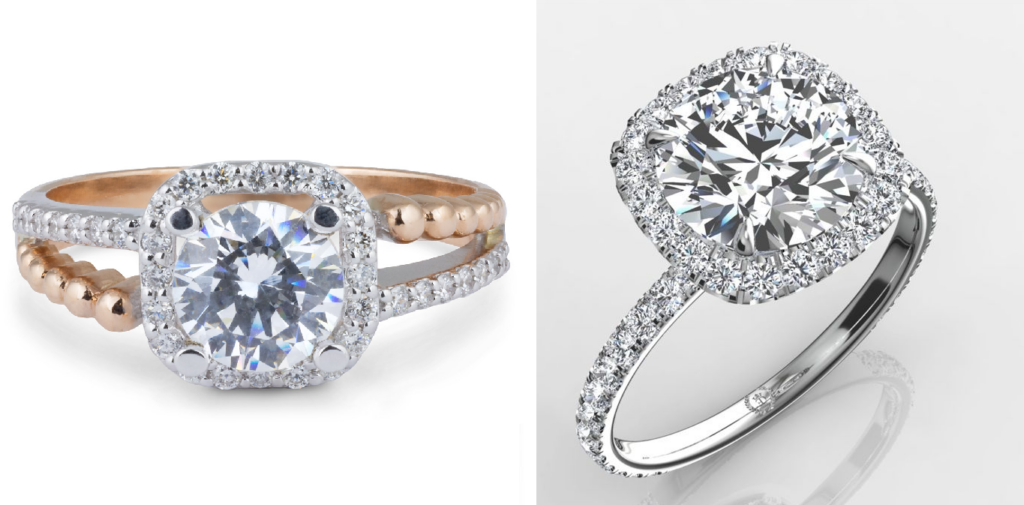
Gap between stone (left); No gap between stone (right)
Ovals are a beautiful alternative to an elongated Cushion in a Cushion cut halo engagement ring. Because Ovals are often brighter than Cushions, they are a good option to consider. However, there are three big considerations when choosing an Oval for a Cushion cut halo engagement ring:
Due to their elongated shape, Ovals can show dark “bowtie” shaped shadows smack dab in the center of your stone. Who wants that? So, when looking for an Oval, always look for even sparkle with no dark bowtie in the center. But, don’t get too carried away, you do want some dark areas (we call that “contrast”) – stones without contrast look pretty dead. In other words, find a good balance of light and dark spots evenly spaced throughout your stone – this will make your stone super sparkly and lively. Do Amore’s founder and CEO, Krish, proposed with an Oval! Learn more about them here.
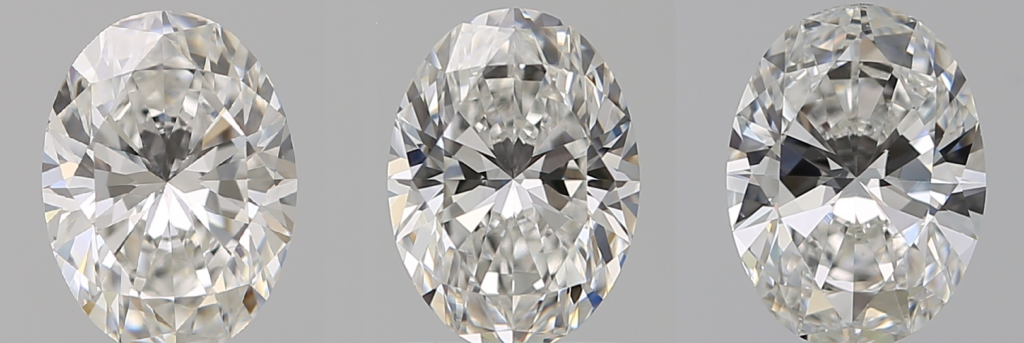
Not enough contrast (left) vs Ideal Oval cut (middle) vs Bowtie (right)
Just like elongated Cushions and Rounds, Oval diamonds in Cushion halos can have shape and gap issues which can make the ring look poorly finished. So, your jeweler should follow the shape of your Oval when creating your halo to ensure that they look “made for each other.” That’s what we here at Do Amore do! Also, demand that there is no awkward gap between the Oval stone and the Cushion halo, which can cause distraction.
I’m here for ya! Send me an email with your ideas and questions, and I’d be happy to help you choose the perfect Cushion cut halo engagement ring within your budget. My name is Corinne, I’m Do Amore’s gemologist, and my help is free!
Congratulations! You’re getting engaged! It’s such a happy time. However, it can also be a stressful one. How do you choose the right engagement ring? What diamond shape is best? How do you make sure it’s worth what you pay? There are so many questions. Luckily, there are some tips and tricks along the way to make sure you pick the perfect diamond shape for your taste and your finger. Let’s explore.

Round diamonds are exactly what they sound like – diamonds with a circular outline. Since their creation, Round diamonds have been the most popular shape in the world. They are classic and timeless. They are also the most brilliant! In fact, gem cutters and mathematicians have spent decades refining the Round brilliant to make them the most sparkly diamond out there. This is because, out of all the diamond shapes, the facets of a Round Brilliant are the most ideally aligned. In other words, when light enters an ideally proportioned Round Brilliant, it bounces around within the gem, and then almost all of it sparkles back out at you, multiplied!

Luna Engagement Ring with 6.4mm Round Diamond
Anyone who wants MAX sparkle. Round diamond shapes are great for, literally, everyone. Because of their maximum sparkle, almost all couples will love Round cut diamonds. Also, because the shape is so popular, almost all settings will accept a Round diamond shape. So, even if a couple wants a more angular or artistic setting, a Round diamond will still likely work and be beautiful.
Because Round diamonds are so popular, they may not be the best choice for couples looking for something truly “unique.” So, if your main goal in your engagement ring is to be different – a Round diamond shape is probably not what you want. Luckily there are at least 9 other diamond shapes out there!
Couples choosing a Round diamond shape should look for an Excellent cut, “eye clean” clarity (usually SI1+), and “white” color (usually H+). In addition, be sure to look at the measurements of your stone to make sure they are maximized within carat weight. In other words, you want the biggest looking stone for your buck! Check out our Round diamond buying guide for more info on how to select the best Round.
Couples that love Rounds should also check out Ovals and Cushions before settling on their diamond shape. Both Oval and Cushion diamond shapes have soft curves with great sparkle, just like Rounds. However, Cushions and Ovals are often less expensive than Rounds of similar quality. And Ovals often look larger.

Round vs Oval vs Cushion Diamond Shapes
Princess cut diamonds are square stones with straight edges and 90-degree corners. So, they are very modern diamond shapes. They are “brilliant” cut stones, meaning that they have triangular and kite-shaped facets that produce a lot of sparkle. The modern Princess cut was designed in 1980, and it is one of the newest diamond shapes to be developed. Of the “square” diamond shapes out there, Princess Cuts use the most diamond rough. As a result, Princess cuts are often less expensive than the other square shapes.

Charu Engagement Ring with 6.2mm Princess Diamond
Couples who want a more modern look. Because of its straight edges and hard corners, Princess cut diamond shapes are best for couples looking for a lot of sparkle, but with a more modern look than a Round diamond. Because of Princess cut’s popularity, couples looking for instant recognition from friends and family will also like Princess cut’s appeal.
Princess cut diamond shapes are the second most popular diamond shape searched for today. So, couples looking for something “unique” may wish to look at less common square shapes, such as Radiant or Asscher. In addition, couples concerned with classic appeal may wish to consider a shape with a more well-established history. Because the Princess cut is a relative newcomer, there have not been many celebrity Princess cuts, or highly recognized Princesses, to cement its timeless appeal. So, if this is a concern for you, you may wish to consider a Radiant diamond that has a high-status history.
One of the most important things in choosing a beautiful Princess is making sure the stone has even contrast. A great Princess will be lively when rocked back and forth, showing light and dark flashes. Another thing to consider is color. Princess cuts can show color more easily than Rounds, so look closely for color. Finally, as with most diamond shapes, maximize your measurements! Carat weight is how heavy a stone is, not how it measures. So, look for wide and tall measurements within Ideal parameters! Check out our Princess cut diamond buying guide for more info on how to select the best Princess.
Couples that love Princesses should also check out Radiants and Asschers. Both Princess cuts and Radiant diamond shapes have modern, straight edges and great sparkle. Radiant cuts have a longer history, and grace more high-end engagement rings, than Princess cuts. Asscher cuts are square stones with a unique mirror-like sparkle, they are quite rare.
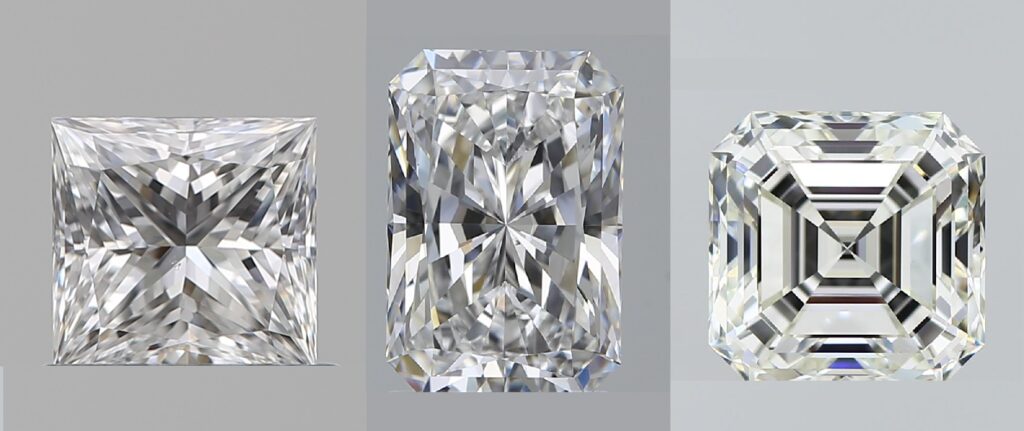
Princess vs Radiant vs Asscher Diamonds
Cushion cut diamonds are square or rectangular diamonds with soft, rounded corners – like a pillow! Cushions were the first “brilliant” diamond shape to be developed, straight out of the mines. This traditional faceting is still sought after today. In addition, newer faceting patterns have been developed which show a “crushed ice” type of brilliance. As a result, all Cushions are different.
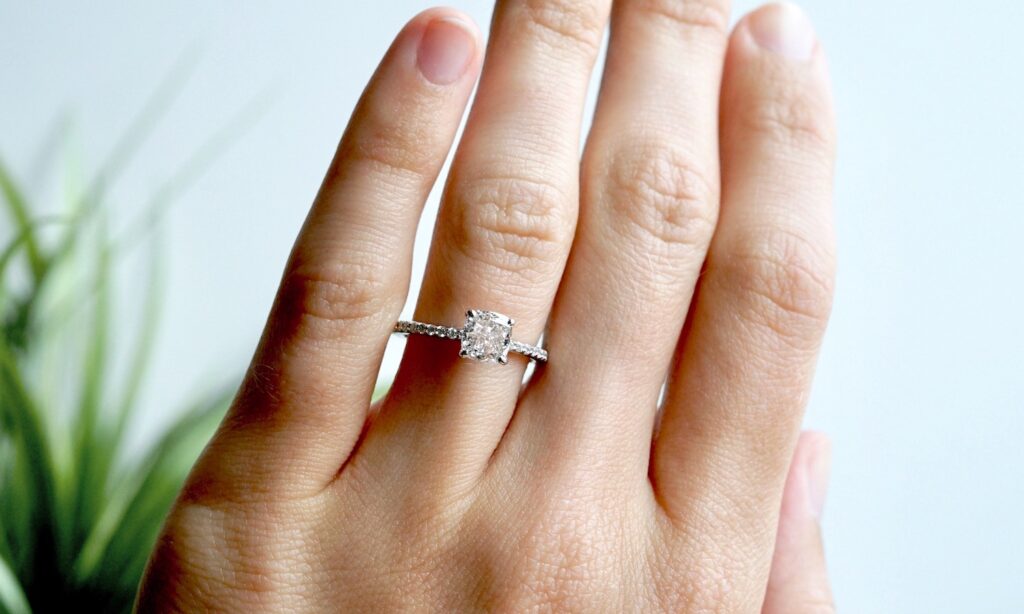
Diana Engagement Ring with 6.1mm Cushion Diamond
Because of its vintage history, many couples that choose Cushions also love other antique things. Do Amore’s gemologist, Corinne, has a Cushion and loves all things vintage. As it is a brilliant-cut gem with soft lines, Cushions also appeal to couples seeking a “different” look while maintaining a traditional vibe. Finally, a Cushion diamond shape’s big flashy sparkle often also attracts playful couples, looking for something more whimsical.
Cushion diamond shapes are notorious for being cut pretty deeply. Not all, but many. So, if size is your number one priority, a Cushion is maybe not the best shape for you as you’ll have fewer options. Couples that want a big, elongated look should also consider an Oval.
Because of the multiple ways Cushion cuts are faceted, couples choosing Cushions should first decide whether they like vintage big flash, or crushed ice brilliance. Also, because Cushions are often cut deeply, couples should make sure to maximize their measurements within carat range. In other words, make sure your diamond isn’t carrying all its weight at the bottom where you can’t see it! Check out our Cushion cut diamond buying guide for more info on how to select the best Cushion.
Couples that love Cushion diamond shapes should also check out Radiants and Ovals. Both Ovals and Radiants are brilliant cut, like Cushions, and have a unique look. Whereas Ovals are softer shapes than Cushions, Radiants are more modern. Both give a unique, elongated appearance.

Elongated Cushion vs Oval vs Radiant Diamonds
Oval cut diamonds are cut much like Rounds, with an elongated shape. First designed by Ideal Diamond creator Lazare Kaplan in 1957, Ovals are “brilliant” cut. This means they produce a bunch of sparkle! Because of their long, slender shape, Ovals often look larger than Rounds of the same carat weight.
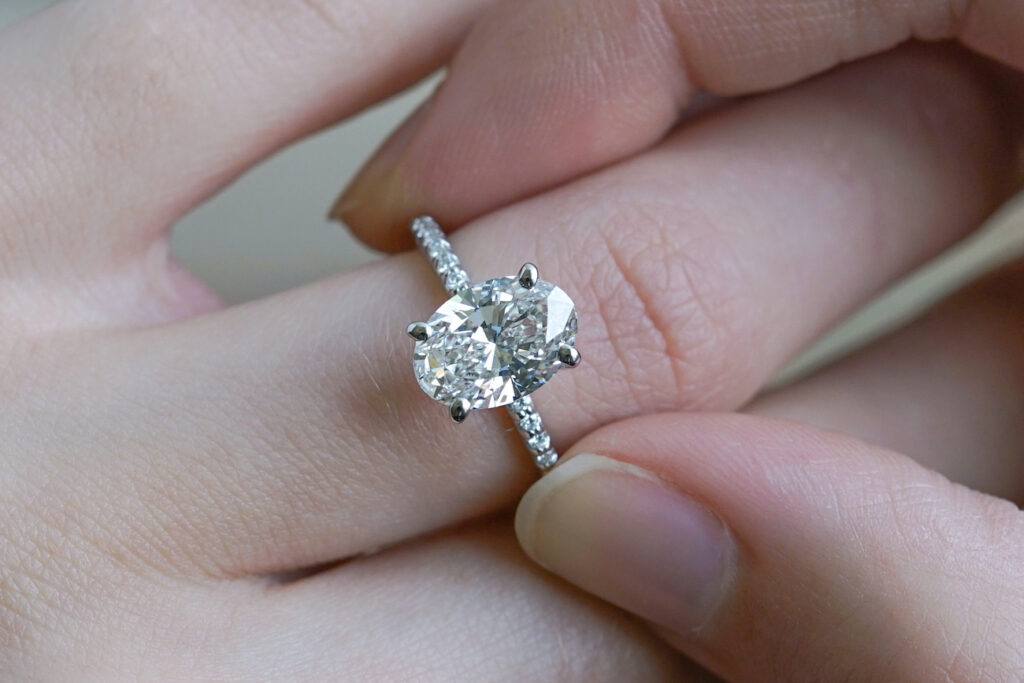
Diana Engagement ring with 10x7mm Oval Diamond
Because of its familiar shape and traditional lines, Oval diamond shapes are a lovely choice for couples who don’t want something super traditional, but still want something classic. Do Amore’s founder, Krish, proposed with an Oval diamond!
Oval shaped diamonds are a classic, traditional choice. In other words, couples looking for a more edgy, modern look will not find it in an Oval. Instead, couples should seek out hard-edged diamond shapes like Princess, Radiant, and Emerald.
Oval cuts can show a dark “bowtie” shadow in the center due to its long shape, so couples should look for gems that do not have bowties. Also, Ovals can show more color in their top and bottom than other shapes, so look out for consistent color as well! Finally, look for a pleasing outline. The Oval shape is why you love the stone – make it pretty! Click here to learn about length-to-width ratio and how to choose a pleasing Oval shape in our Oval diamond buying guide.
Couples that love Ovals should also check out Marquise and elongated Cushions. Just like Ovals, Marquise stones are graceful, slender shapes that elongate the finger. And, Marquise cut diamonds look even larger than Ovals of the same carat weight! Elongated Cushions are rectangular gems with soft corners. So, this diamond shape will also appeal to couples looking for a slim outline. Cushions and Marquise sparkle a bit differently than Ovals do, so comparing these gems side-by-side is a great way to confirm you really want an Oval!
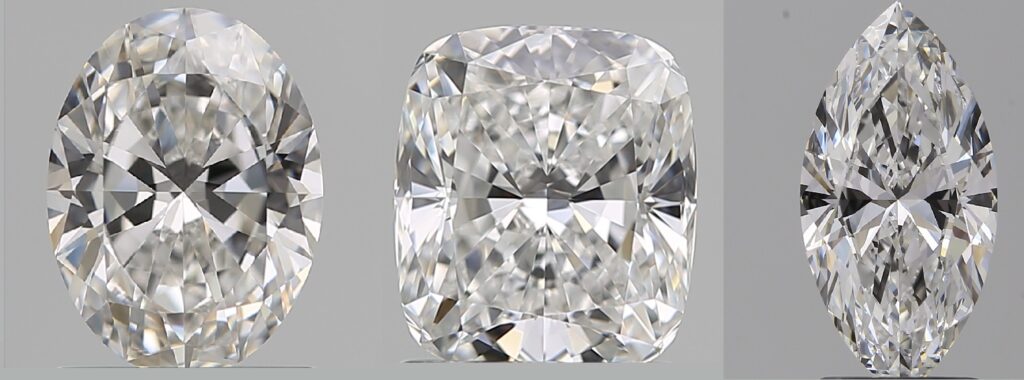
Oval vs Elongated Cushion vs Marquise Diamonds
Emerald cut diamonds are long, rectangular diamonds with facets that create a “hall of mirrors” effect. They are the first of two “step” cut diamonds we will discuss. Step cuts are faceted much differently than “brilliant” cut diamonds. Instead of the traditional “sparkle” you see in most diamond shapes, Emerald cuts glimmer. They were designed to showcase color and high clarity. In other words, their sparkle does not mask inclusions or slight color tint like other diamonds. For this reason, they are a popular choice for high-end engagement rings.
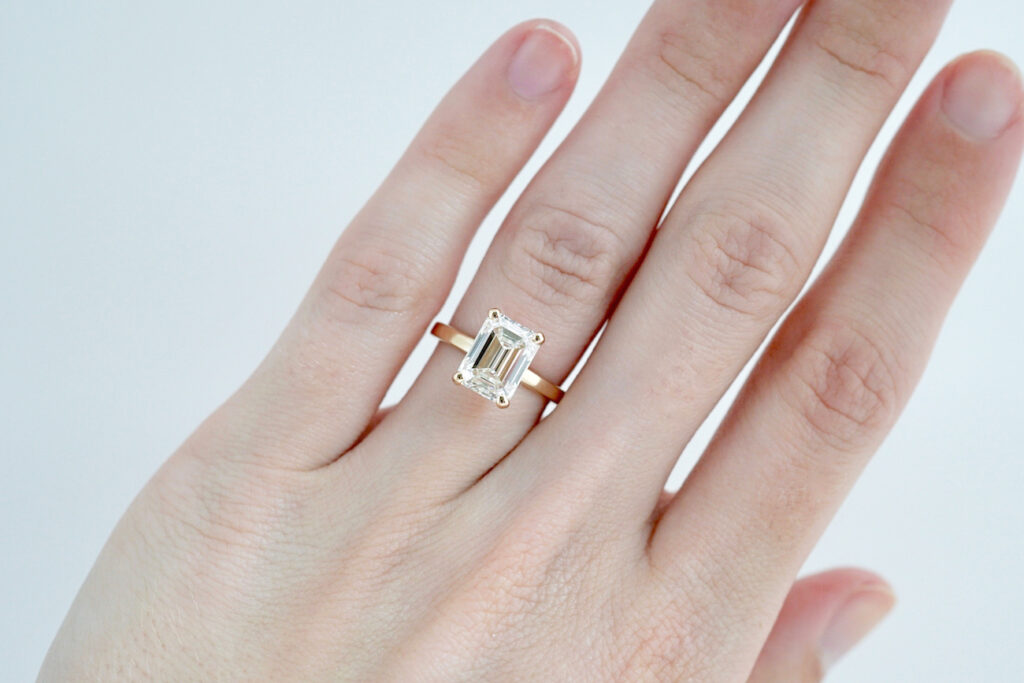
Asha Engagement Ring with 9.5x7mm Emerald Diamond
With its soft mirror-like glimmer, Emerald cuts are a great choice for couples wanting something more subtle. An Emerald cut’s elegant, old-world glamour is also an excellent choice for those who want their engagement ring to exude high-end quality. Because of its color and clarity needs, the best Emerald couples are those that don’t mind spending a bit more on their center stone.
The big takeaway about Emeralds is that they do not “sparkle.” So, if maximum sparkle is your goal, an Emerald cut is not for you. Couples looking for a rectangular, sparkly stone should check out Radiants. Also, because of its necessary high color and clarity, couples looking for bang for their buck will not find it in an Emerald.
Emerald cuts can show a dark “black box” in the center due to its mirror faceting. So, when rocking an Emerald cut back and forth, look for vertical dark and light play, without a boxy horizontal dark area. Because Emeralds show inclusions so easily, always remember to pay close attention to clarity. Most Emerald cuts need to be at least VS1 (and often VVS2+) to ensure eye clean clarity. Click here for more tips and tricks on choosing a great Emerald-cut!
Couples that love the rectangular look of an Emerald, but want more glitz, should check out the Radiant cut. Radiants are “brilliant” diamonds with the shape of an Emerald! For those that love the glamorous look of an Emerald, but also need a better-priced stone, check out an elongated Cushion. Elongated cushions, especially those that are more traditionally faceted, give a soft glimmer similar to an Emerald. But, because Cushions are brilliant-cut, couples can often get away with lower color and clarity, making them a more affordable choice than Emerald. Finally, those that love Emeralds will also love the lesser-known Asscher cut. Asschers are square Emerald cuts!

Emerald vs Radiant vs Elongated Cushion vs Asscher
Radiant cut diamonds are long, rectangular diamonds with bright, sparkly facets. First faceted in the 1970s, Radiant cuts are the well-kept secret of rectangular diamonds. Not often shown in brick and mortar jewelers, Radiants have been chosen and worn by celebrities for decades. There are several faceting patterns available in Radiants. However, all include wide, clipped corners, like an Emerald cut.
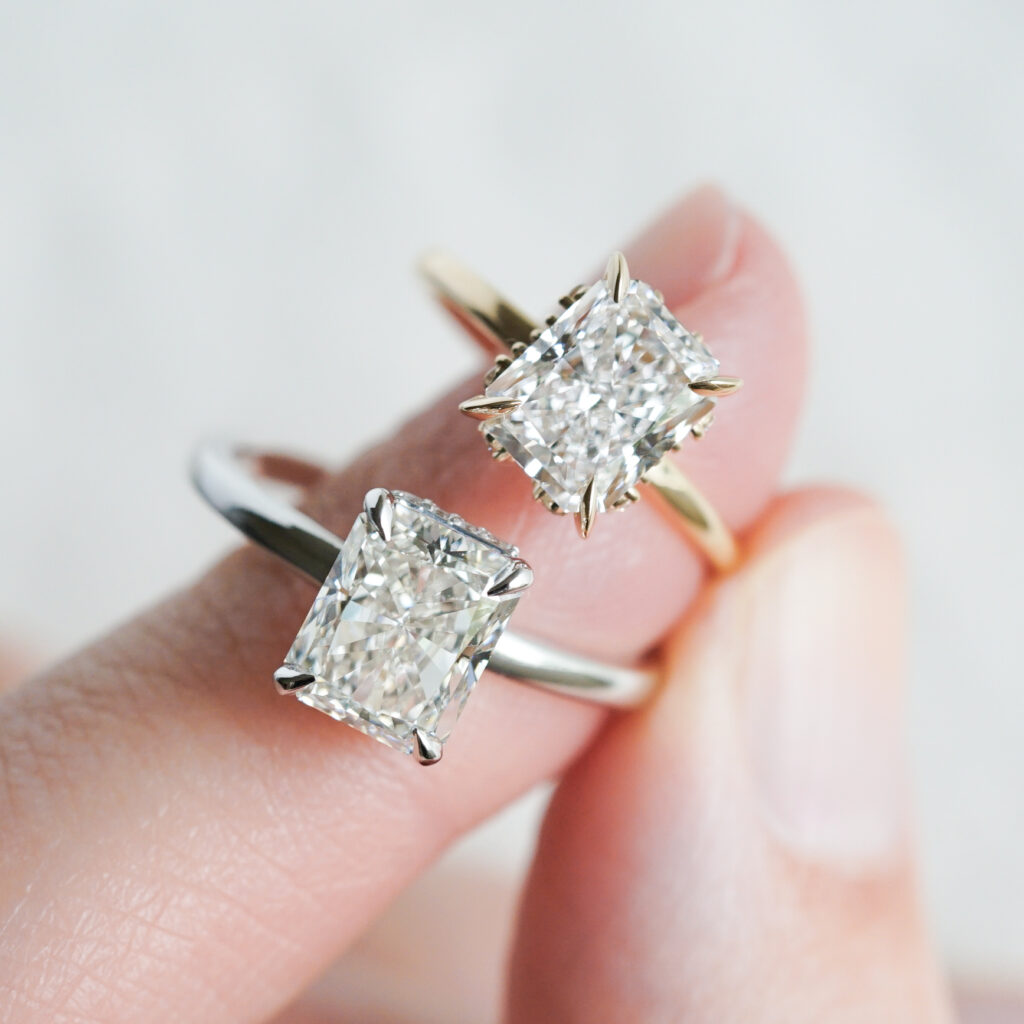
7.5x6mm Custom Radiant and 8x6mm Radiant in Jolie Ring
Radiants are a great pick for couples looking for something a little edgier than a traditional round, and who also want their stone to have great sparkle and established “cred.” Because Radiants have a history as a high-end choice, couples can feel confident choosing a Radiant. Because of its rarity, Radiants are a great choice for those looking for something unique. Finally, Radiants are a great rectangular choice because they don’t need super high color and clarity to look gorgeous.
A Radiant cut’s shape is quite edgy. It has hard lines and clipped corners. So, couples looking for a soft look will not find it in a Radiant. Also, because of its rarity, many people have never heard of Radiant cuts. As a result, couples looking for immediate recognition won’t get it in Radiant, and may wish to look at Princess cuts.
Radiant faceting can either show a more traditional facet pattern, or a “crushed ice” type of look. So, when looking for a Radiant, decide which one of these looks you’re going for first. Also, crushed ice Radiants can show color much easier than other shapes. So, pay attention to color in the top and bottom of the gem, where this “ice” is. You want consistent, white color. For more tips on choosing a great Radiant, check out our Radiant cut buying guide.
Couples that love the rectangular look of a Radiant should also check out elongated Princess cuts and Emerald cuts. Elongated Princess cut gems will give a similar look and will be less expensive than a comparable Radiant. To ensure you are getting the look you want, couples should also check out Emerald cuts, which have the same outline, with very different “sparkle.” Emerald cuts give more of a mirror-like sheen in comparison to Radiant cut’s sparkle. Finally, couples who love the “crushed ice” look of a Radiant should also consider an elongated Cushion, as certain Cushions also show this effect.

Traditional Radiant vs Emerald vs Elongated Princess vs Crushed-Ice Radiant
Pear-shaped diamonds look like a raindrop (or a hot air balloon!) They can be plump, skinny, or traditionally proportioned, depending upon the shape of the rough and the preference of the cutter. They can be worn with the point up, or down, based upon the wearer’s preference. The Pear shape was first designed in the 1400s! So, it has quite a bit of history to its name. Due to its brilliant faceting, Pear shapes give great sparkle.

8x5mm Pear Diamond in Elle ring
Pear shapes are unique in that they are asymmetrical. Whereas the top is an edgy point, the bottom is a graceful curve. So, those looking for a unique or artsy look will love it! This gives the wearer an option to change up the ring’s look simply by turning it upside down. They can also be set sideways or on a diagonal for a truly artistic expression.
Pears are lovely and unique. However, because of their asymmetry, Pears are not very traditional. As a result, this uniqueness makes them not the right choice for everyone. So, if you are looking for a classic, traditional engagement ring, a Pear shape may not be the right fit for you. Also, if part of your diamond shape decision is the stone’s “investment quality,” you may be better off with a more traditional shape like Round, Cushion, or Radiant.
Pear cuts can be slender, traditionally proportioned, or more chubby. I personally love a nice plump Pear. The most important thing is to make sure the shape is graceful. So, the curves should be soft, without pointy areas. And the point should be pointy – else you’ll have an egg! Finally, as color can gather at the tip of a Pear, couples should always look for even coloration. For more tips on how to choose a pretty Pear, check out our Pear-shaped buying guide.
Couples that love Pear shapes may also love a Heart shape. Similar in its asymmetry and unique nature, Heart cut diamonds are a romantic comparison shape. Couples looking at Pears should also compare them to Oval shaped diamonds. Ovals are long, elegant shapes like Pears, but with even more brilliance.
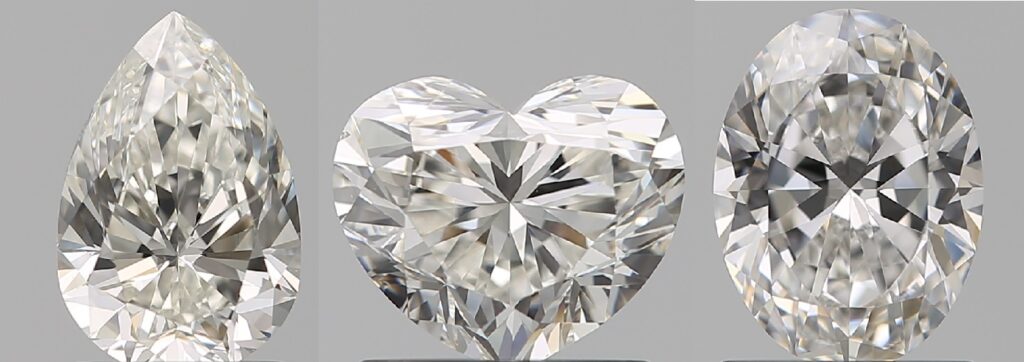
Pear vs Heart vs Oval Diamonds
Heart-shaped diamonds are just what you imagine, a diamond shaped like a Heart! They are brilliant-cut stones, which means they really sparkle. Hearts are the most romantic diamond shape, and also one of the rarest. Like Pears, they can be plump, skinny, or traditionally proportioned. Heart-shaped diamonds have been around since the 1500s and have a royal history.
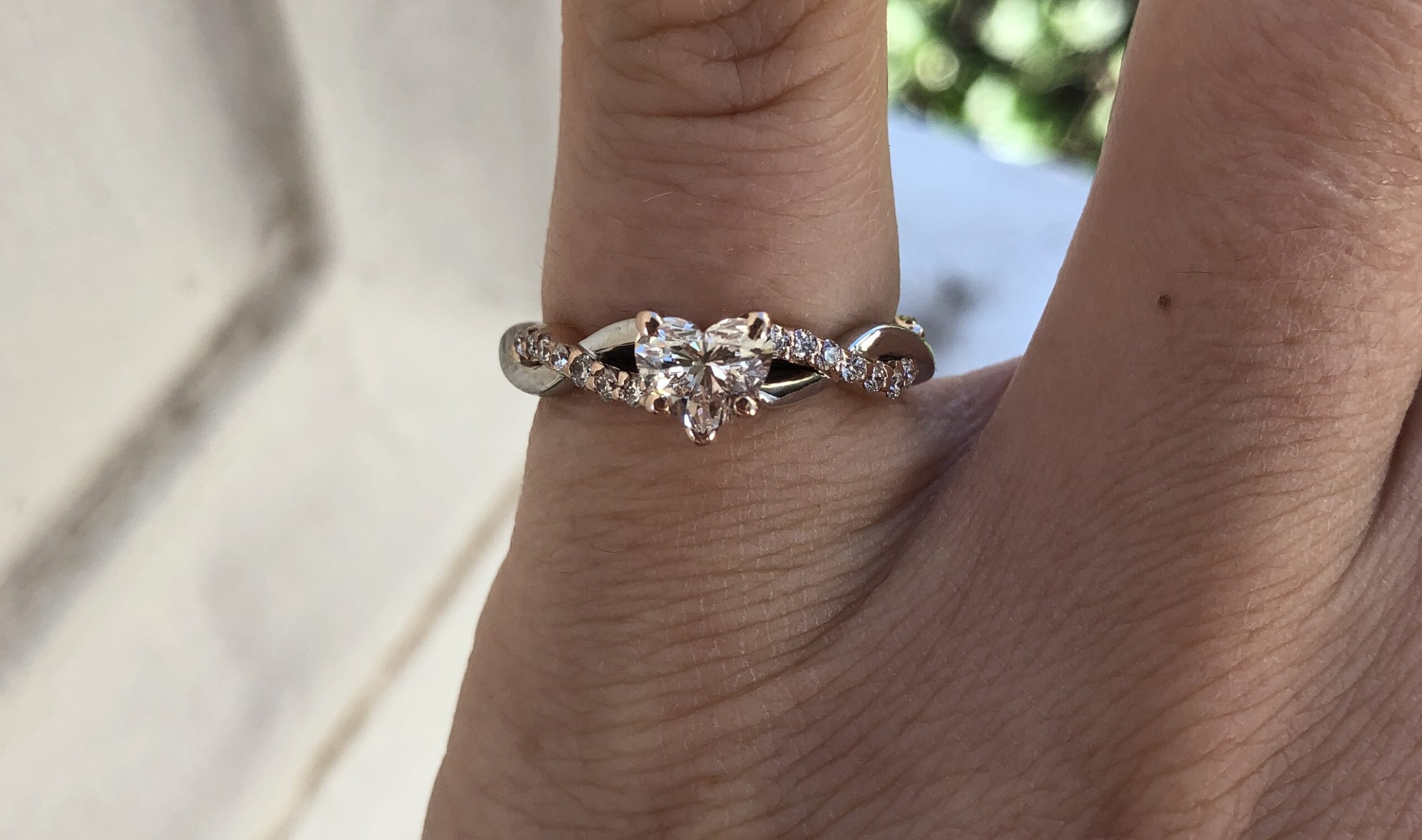
Heart Shaped Diamond in Custom Ring
Heart shaped diamonds are whimsical and unique. They are best suited to romantics that love everything about love. Couples that I know who chose Hearts love rom-coms, all things Disney, and fairy tales!
Some couples love Hearts, and others greatly dislike them. This shape is very personal. So, if you are looking for something that has universal appeal, a Heart shaped diamond is not likely your best bet. This also means that if “investment quality” is a major concern in your ring shopping, you should instead consider a Round, Cushion, or Radiant.
Couples choosing a Heart diamond shape are doing so for its great shape – so that great shape is top priority! Soft “lobes” (the curves of the Heart) and a pointy tip are very important. Hearts can be slender, traditionally proportioned, or more chubby. I tend to advise against slender Hearts, as I don’t think they are as attractive. Finally, as color can gather at the point of the Heart, couples should always look for even coloration. For more tips on how to choose a lovely Heart, check out our Heart-shaped buying guide.
Couples that love Hearts are unlikely to want any other shape. However, for argument’s sake, I tend to suggest that people compare them, just in case! Good shapes to compare with Hearts are Pears and Marquise. Plump Pears have a similar appeal to Hearts, as they are asymmetrical and unique. I also love to show a nice fat Marquise. Plump Marquise have a whimsical appeal too, much like a playing card diamond. And Marquise will look larger!

Heart vs Plump Pear vs Plump Marquise Diamonds
Marquise cut diamonds are almond-shaped stones with points on the top and bottom. They are said to be shaped like a kiss! Designed in the 1700s, Marquise are brilliant-cut gems that look larger than any other diamond shape. Greatly popular in the 1970s and 1980s, Marquise are regaining popularity today thanks to their elegant length and large sizes. Like Pears, Marquise can be slender, traditionally-proportioned, or plump. New designers have been setting them horizontally, whereas traditionally, they are worn vertically to elongate the finger.
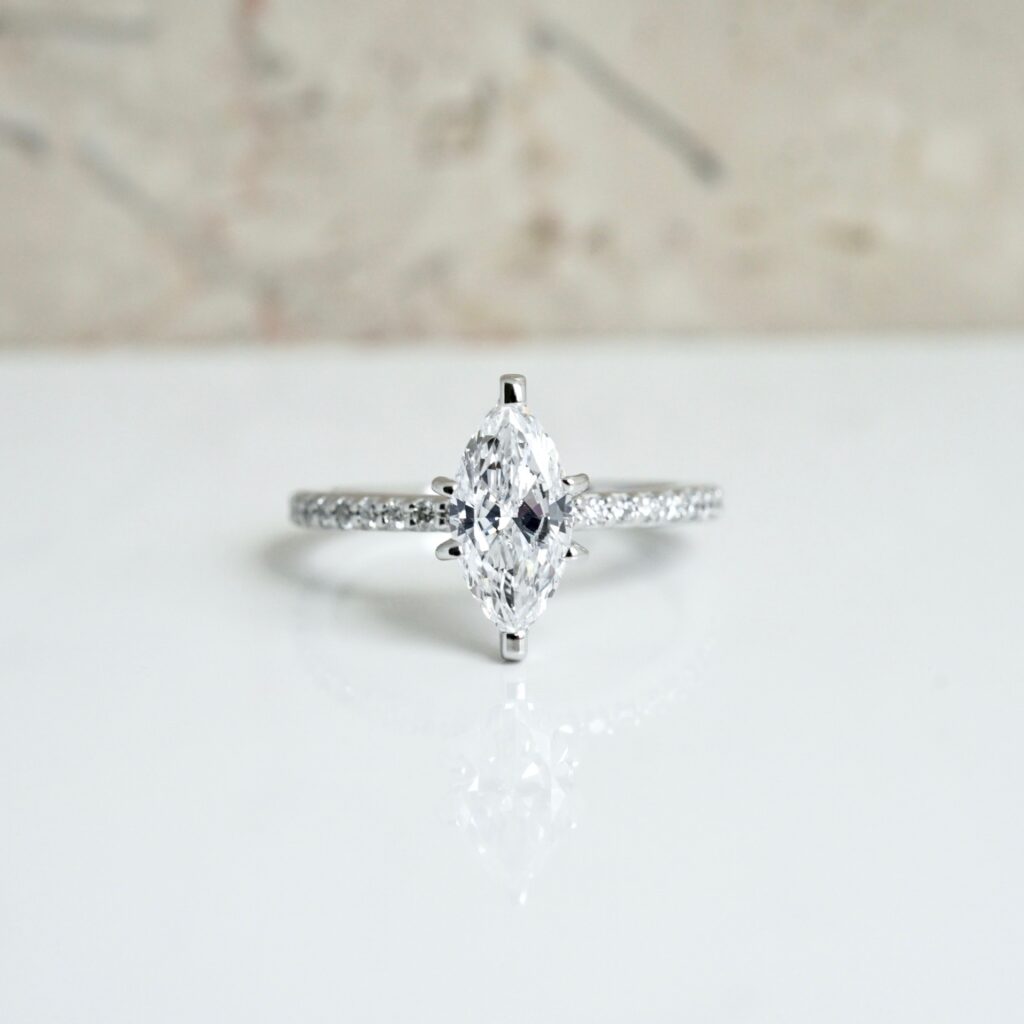
10x5mm Marquise Diamond in Diana Ring
Marquise are a rare and unexpected choice today. Because of the Marquise craze 40 years ago, some couples reject Marquise as a modern option. So, couples that like pushing boundaries may love the idea of shattering expectations with a great, modern Marquise ring. Also, a great reason to choose a Marquise is its amazing ability to look significantly larger than any other shape. So, those looking for a statement piece? They should check out a Marquise.
The Marquise’s popularity in 1970-1980 biases some people against them. Perhaps their mother had a Marquise, and they want something different. So, couples that have a pre-set notion that they dislike the shape will likely not be talked out of it. But I’ll try. Consider that Catherine Zeta-Jones’, Ashlee Simpson’s, and Portia de Rossi’s engagement rings are all beautiful Marquise!
Couples choosing a Marquise diamond shape typically do so for its elegant shape and size. So, choosing a stone with a pleasing outline is a big deal. Tips include making sure the curves of your stone are soft, not awkwardly flat or boxy, as well as that your points are actually pointy. In addition, Marquise can carry some extra color in their points, so always look for even color. For more tips on Marquises, check out our Marquise cut buying guide.
Couples that love Marquise are likely to also enjoy the appeal of Ovals and Pears. The rounded bottom and pointed top of a Pear is reminiscent of the Marquise’s outline, but a bit edgier. An Oval, on the other hand, gives a Marquise’s elegance but offers more brilliance.
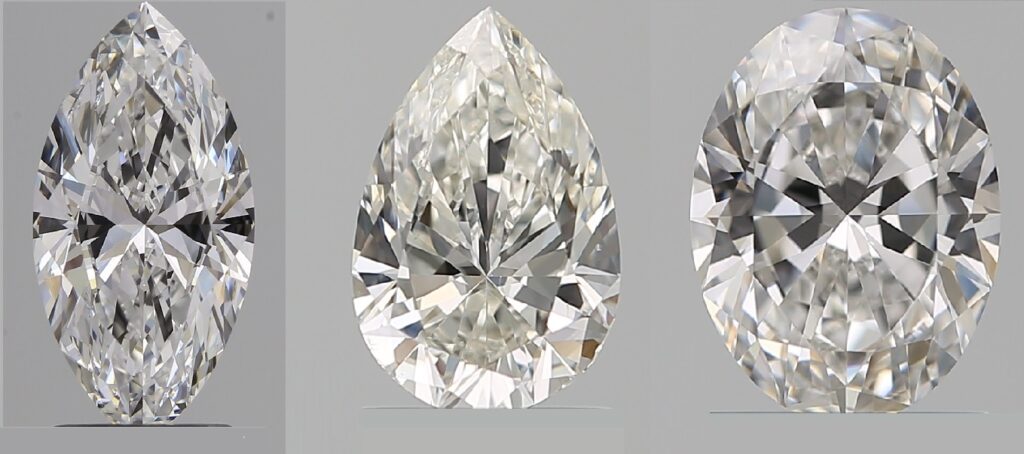
Marquise vs Pear vs Oval Diamonds
Asscher cut diamonds are square stones with clipped corners and rectangular facets that create a “hall of mirrors” effect. Born from Emerald cuts, Asschers are “step” cut diamonds, which glimmer instead of “sparkle.” Asscher cuts flash between light and dark when you rock them side to side. Like their sister cut, Emerald, Asschers show off high color and clarity. So, their faceting does not hide inclusions or color tint. Instead, they magnify them. For this reason, couples that like high-end things often love Asscher cut stones.

Asscher cut diamond ring
With its hall of mirrors effect, couples love Asschers for their simple elegance and Art Deco appeal. As they do not sparkle like other gems, they are a good choice for low key couples, and also couples who want to show relaxed status. Because Asschers require high-end color and clarity, the best Asscher couples are those that don’t mind spending more on their center stone.
Again, Asscher cut diamonds shimmer, they do not sparkle like other diamonds. So, if max sparkle is your goal, an Asscher is not your cut. Couples looking for a square, sparkly stone should check out Radiants and Princesses. Because of its high color and clarity needs, couples looking for a great bargain will likely not find it in Asscher.
Asscher cuts can show a dark “black box” in the center, due to its mirror-like faceting. So, when viewing an Asscher, look for well-proportioned glimmer without a distracting black box. Because Asschers show inclusions so easily, another thing to pay close attention to is clarity. Most Asscher cuts need to be at least VS1 (and often VVS2+) to ensure eye clean clarity. Click here for more tips and tricks on choosing a great Asscher cut!
Couples that love the square look of an Asscher, but want more glitz, should check out the Princess cut. Princess cuts are “brilliant” diamonds with a square shape! For those that love the old world glamour of an Asscher, but need a better value, Cushion may be the ticket. Vintage and shimmery, square Cushions are often a better price than Asschers. Finally, those that love Asschers will also love their sister cut, the Emerald. In fact, you may find a better price in a squarish Emerald cut, than a perfectly square Asscher!

Asscher vs Princess vs Cushion Diamonds
Sure can! I’d love to talk with you about diamond shapes, comparison shapes, and how to pick the best shape for your lifestyle and finger! Email me or send us a note here with pictures, ideas, or questions and I’ll help you choose the perfect shape for you!
Oval diamonds are my favorite type of diamond. They are elegant, unique, and very brilliant. I know a lot about them, and I proposed with one myself. In fact, the oval diamond and dainty engagement ring at the top of this page is the ring I purchased for my fiancée! So, if you are looking for oval diamond engagement rings, here are some of the benefits of choosing one, as well as very important tips.
When most of us think of diamond size, we envision the top surface of a round diamond. However, if you replace that round diamond with an oval of the same carat weight, the oval’s top would appear larger! This is because ovals often have greater surface areas than round diamonds of the same weight. For example, the average 1 carat oval diamond’s surface is 10% larger than the average 1 carat round. This means that you can get a diamond that looks larger, for a lower price.
Because an oval is an elongated shape, oval diamond engagement rings give the illusion of longer, more slender fingers. So, if you’re seeking elegance, you’ve found it! Those with long, thin fingers will also love how an oval compliments their finger.
Round, Emerald, and Oval Diamond Engagement Rings
While ovals are more rare than round and princess-cut diamonds, they are also in less demand. You should not have to increase your budget when looking for oval diamond engagement rings. In fact ovals are typically about 20% less expensive and a similarly sized round!
| Round (H/VS2) | Oval (H/VS2) | |
| .75ct | $2,700+ | $2,000+ |
| 1.00ct | $5,000+ | $3,800+ |
| 1.50ct | $9,500+ | $8,200+ |
Another option for saving money is considering moissanite, lab diamond, or sapphire for your oval engagement ring! That is because each of these beautiful options is much more affordable than a natural oval diamond. Oval sapphires are classic. In fact, Kate Middleton’s engagement ring (that was originally Princess Diana’s) is a beautiful oval sapphire. We love sapphire so much we sell it in all of its different beautiful colors. For example, why not consider an oval blue, yellow, or pink?
Oval moissanite, oval white sapphire, and oval lab diamonds are also stunning white natural diamond alternatives. Each of these options is bright, beautiful, durable, and classic!
Oval Moissanite engagement ring vs Oval White Sapphire engagement ring (bottom)
Warning: Oval diamonds are not graded by the GIA for cut quality. In order to end up with a beautiful oval diamond engagement ring, it is important to make sure your jeweler understands optimum oval cut specifications. The below table should help you narrow down your choices. However, never buy an oval based on the certificate only. You really need to find someone that will perform a visual inspection before you purchase the stone.
| Ideal/Excellent | Very Good | |
| Table | 53-63% | 51-52 or 64-66 |
| Depth | 57.5-62% | 55.5-57.4 or 62.1-65 |
| Length-to-Width | 1.30-1.50 | 1.25-1.29 or 1.51-1.55 |
| Bowtie | No/Minimal Dark Bowtie | Slightly Dark Bowtie |
All oval diamonds in our diamond search engine will have a length to width ratio listed. A diamond’s length to width ratio is, literally, the length of the stone divided by its width. So, this ratio will help you gauge how slender or plump the diamond is. A greater length to width ratio means the diamond will be longer and skinnier, while a lower length to width ratio means the diamond is more plump. For reference, a round diamond has a length to width ratio of 1. Most people prefer ovals with a length to width ratio from 1.3 to 1.7, however this is completely up to you. I personally prefer ovals with a length to width ratio in the 1.4 to 1.6 range. Our gemologist, Corinne, loves super elongated ovals!
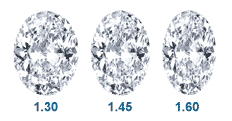
An oval diamond is a “brilliant” cut, much like a round diamond. So, even though a round diamond will have the most brilliance, the oval cut is a very close second! So, oval diamond engagement rings are perfect for someone who likes the brilliance of a round diamond, but wants something more unique.
Most oval diamonds have something called a bow-tie effect. We call it a bowtie, because this sometimes-dark section in the center of an oval looks like a gentleman’s bowtie! All ovals have a “bowtie” as a result of its middle faceting being a touch different than its tips. Specifically, its middle is deeper with short facets, and its tips are shallower with long facets. While most diamond cutters agree that this is part of the beauty of the oval, you do not want the bow-tie effect to be dark or overwhelming.
Because bow-tie effect isn’t taken into consideration when grading a diamond, it isn’t noted on a diamond certificate. So, the only way to gauge how severe a diamond’s dark bow-tie is, is through visual inspection. For example, below is a picture from the visual inspection I performed before purchasing my fiancee’s diamond. As you can see, her diamond has a small bow-tie in the middle. I like this picture because the contrasting black background makes the bow-tie easy to see! And, as you can tell from its regular-lighting photo, once set, the bow-tie effect is fairly small and beautiful.
Slight bowtie (left); Stone after setting
Yes! Since oval diamond engagement rings are my favorite, feel free to ask for me personally (my name is Krish). You should always have your jeweler perform a visual inspection of your oval cut stone to make sure it sparkles evenly and does not have a severe bow-tie. If you’re considering Do Amore for your oval diamond engagement ring, then send us a note here or email us at care@doamore.com! We will assist you in finding a beautiful oval, without a severe bow-tie, that’s within your budget!